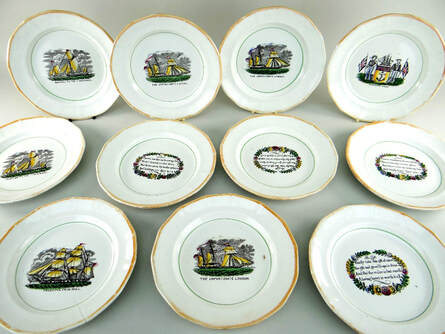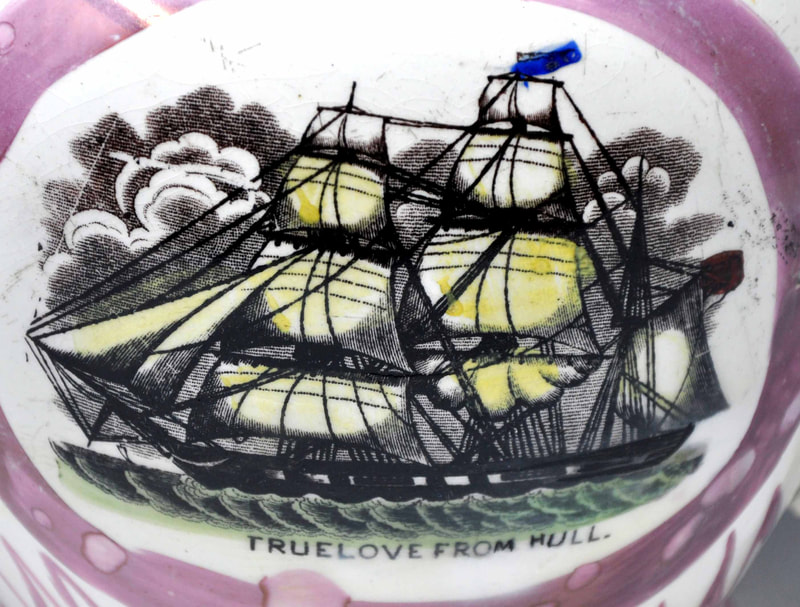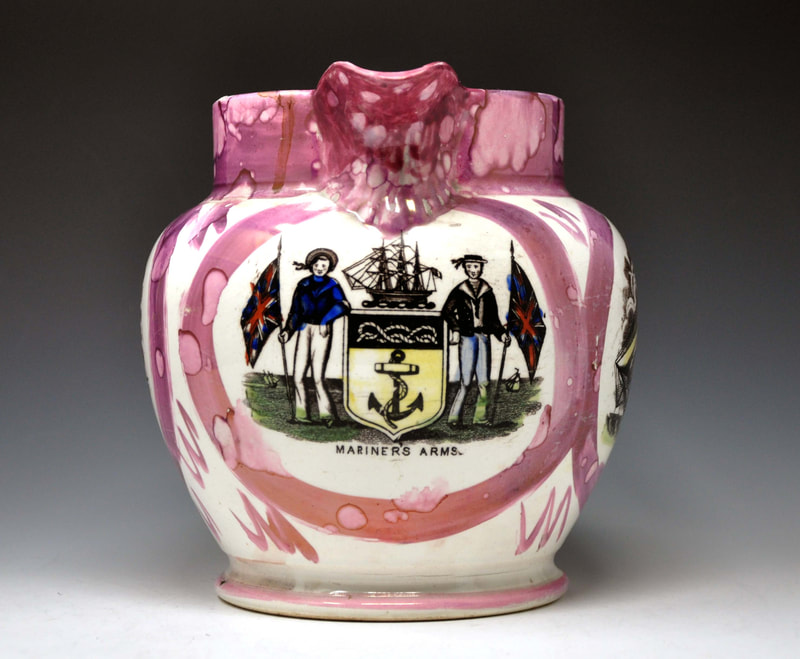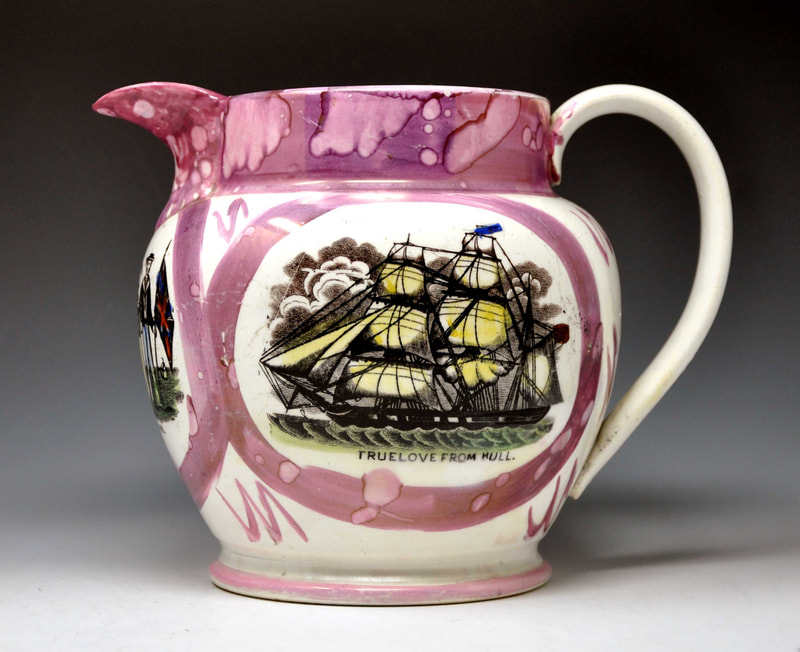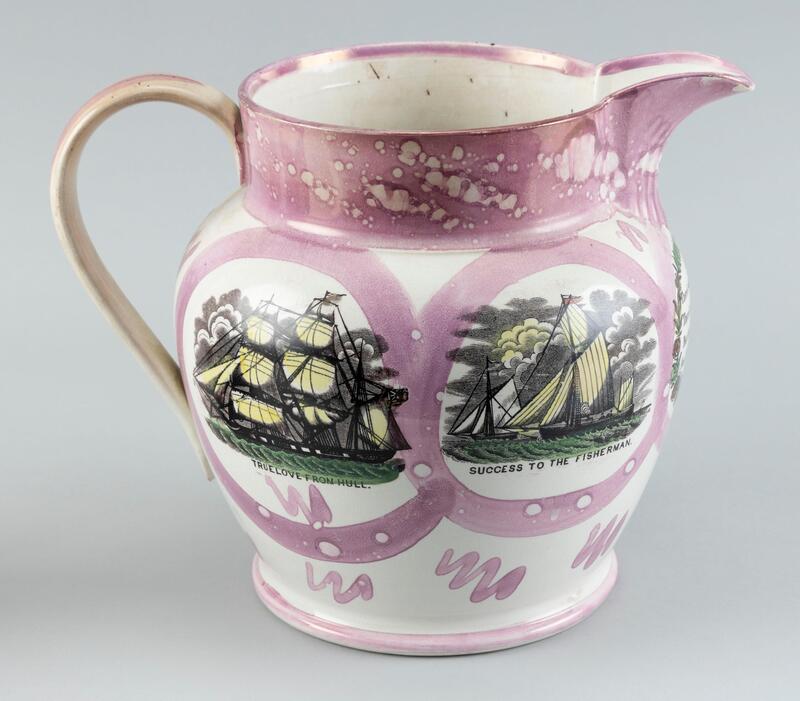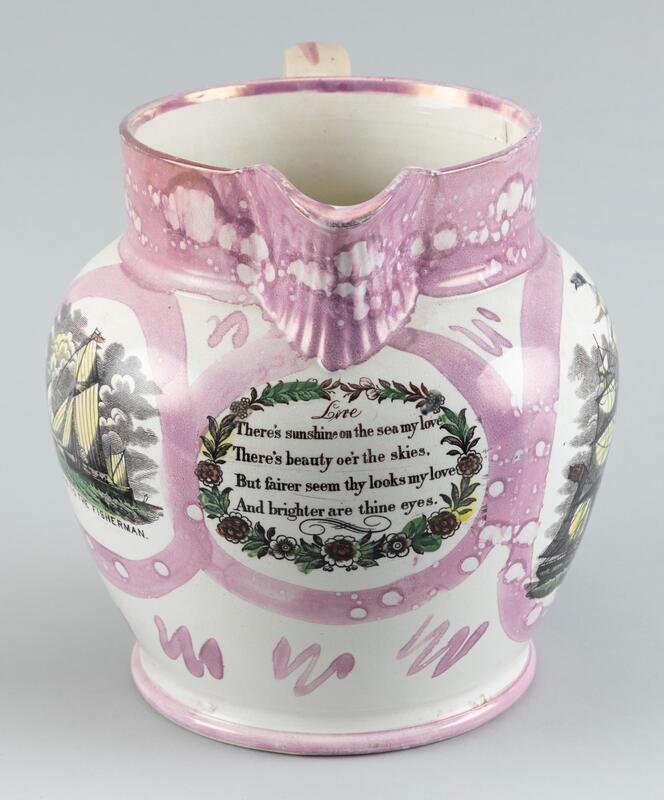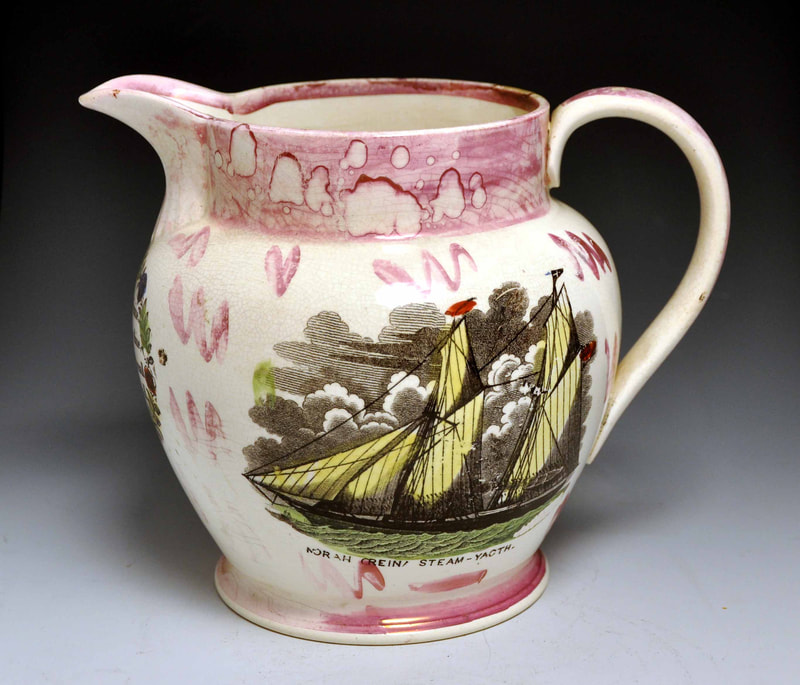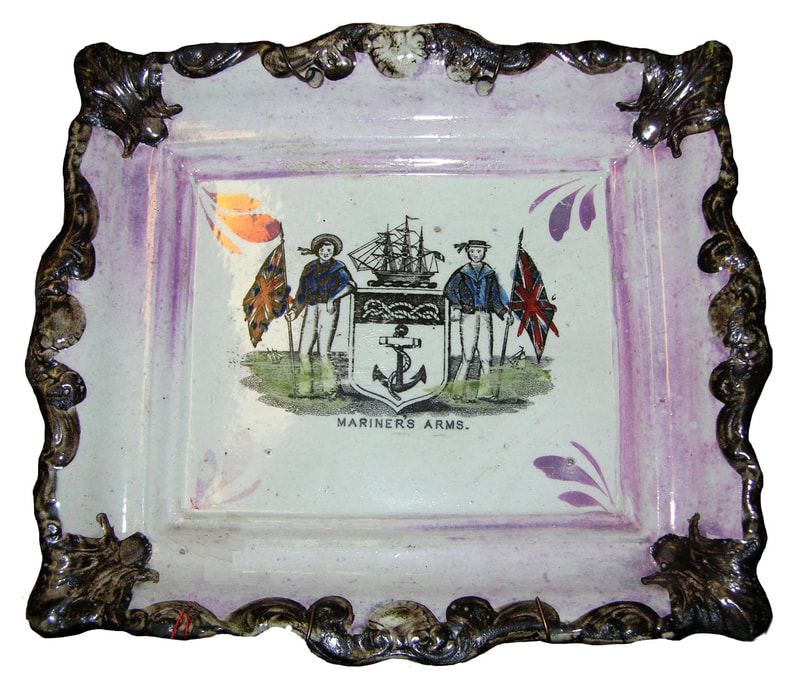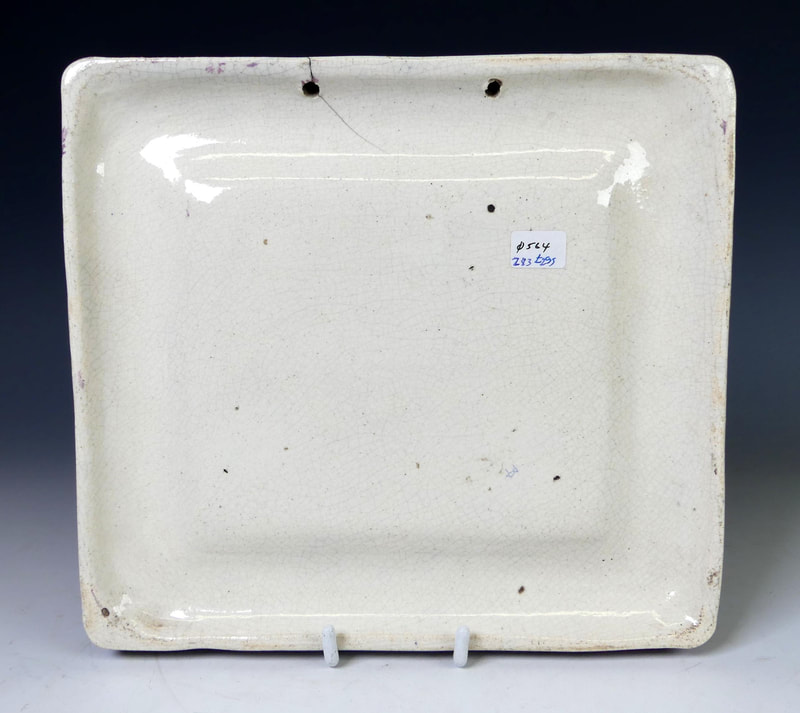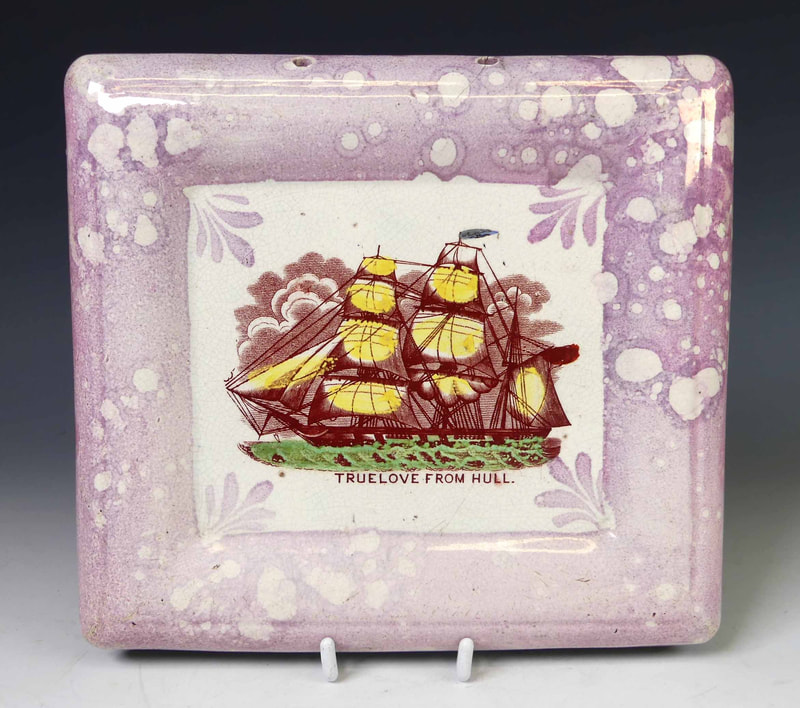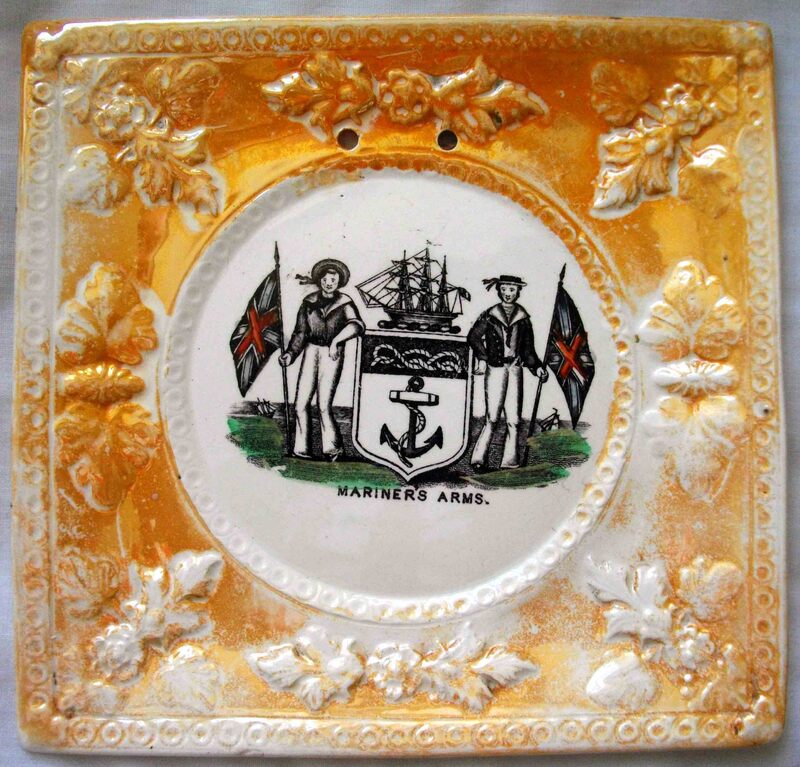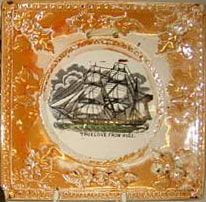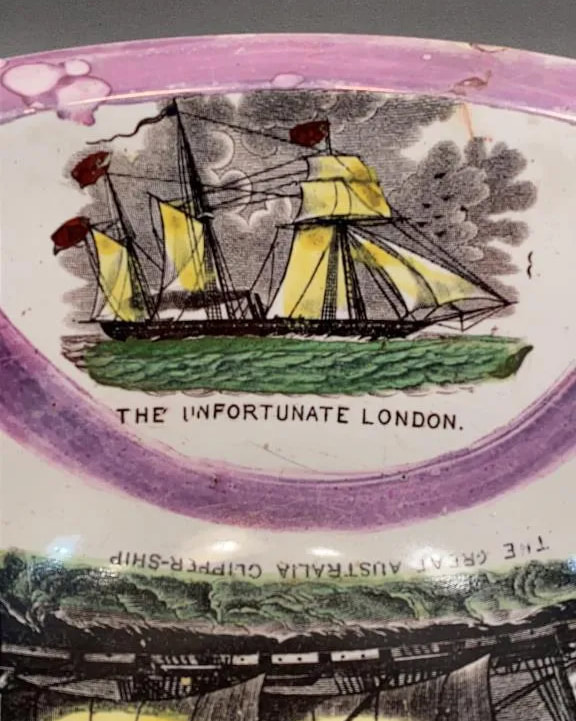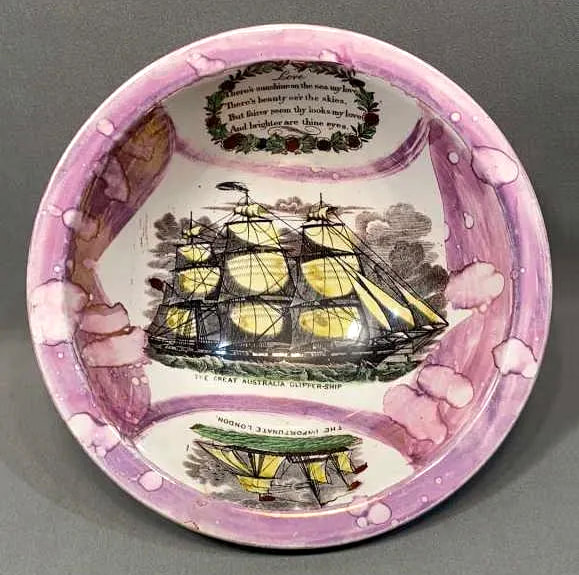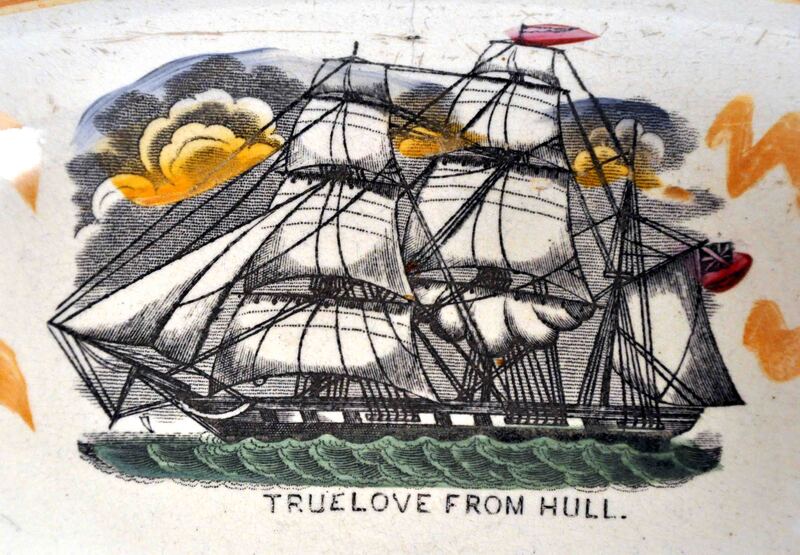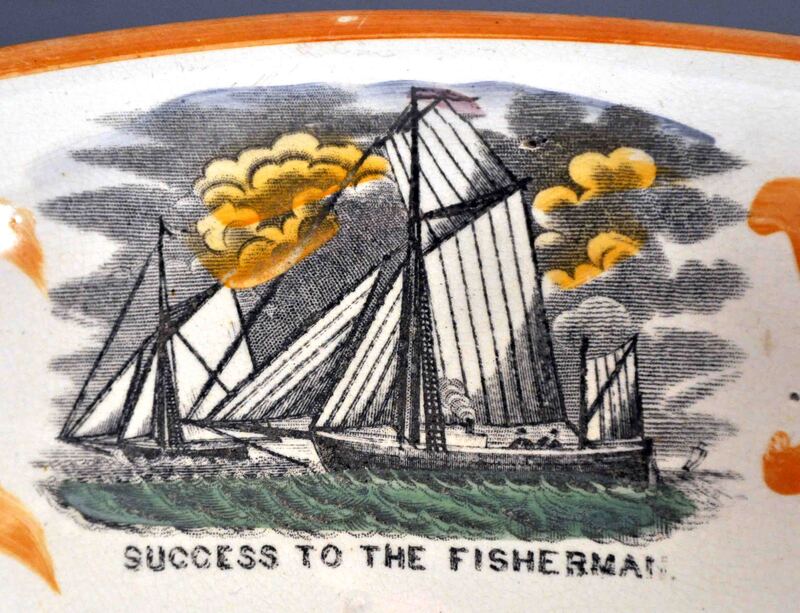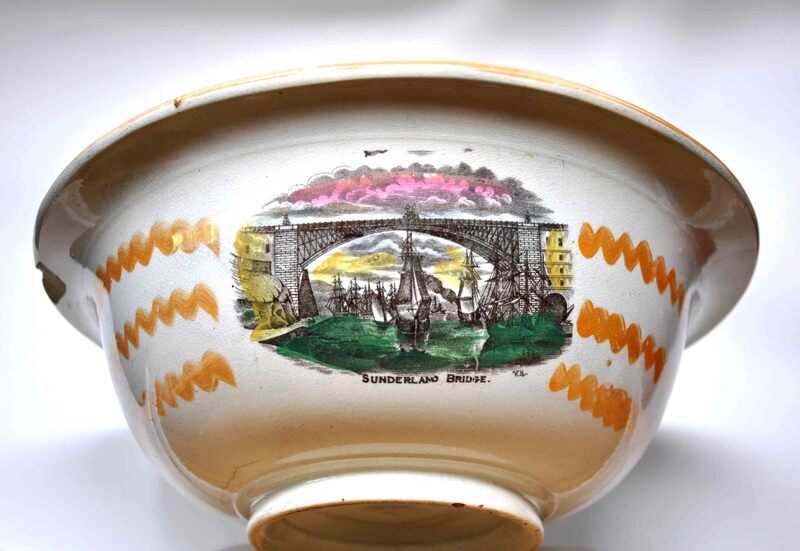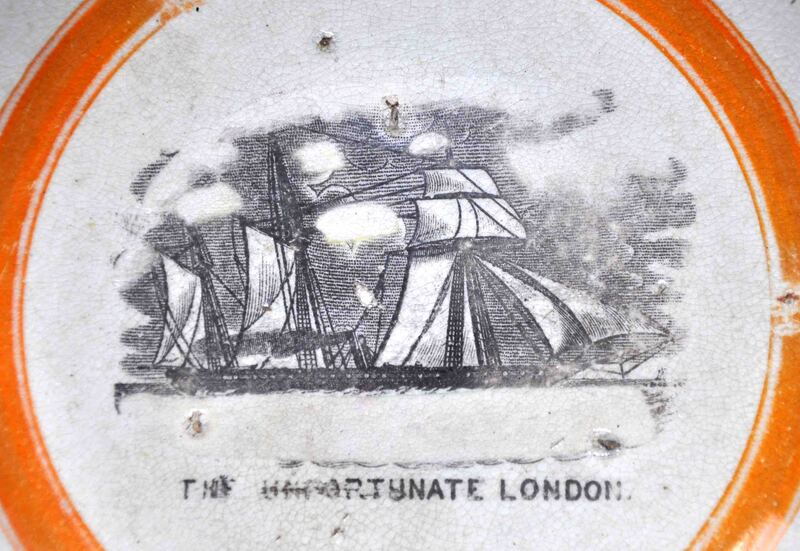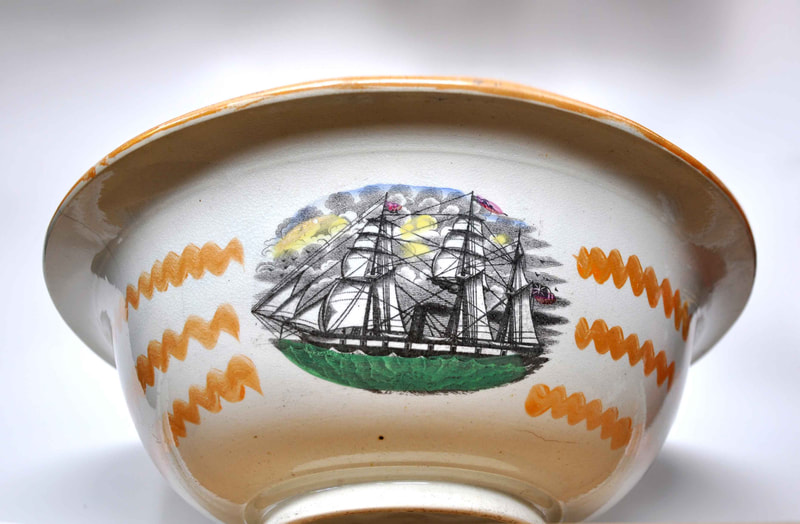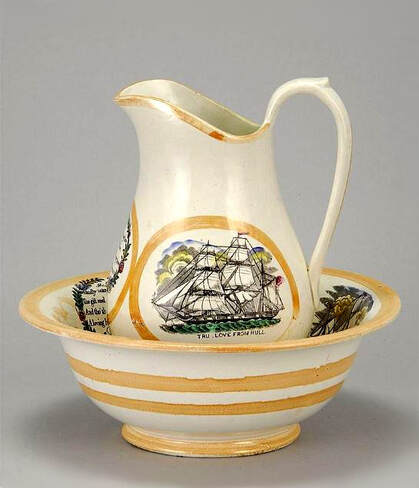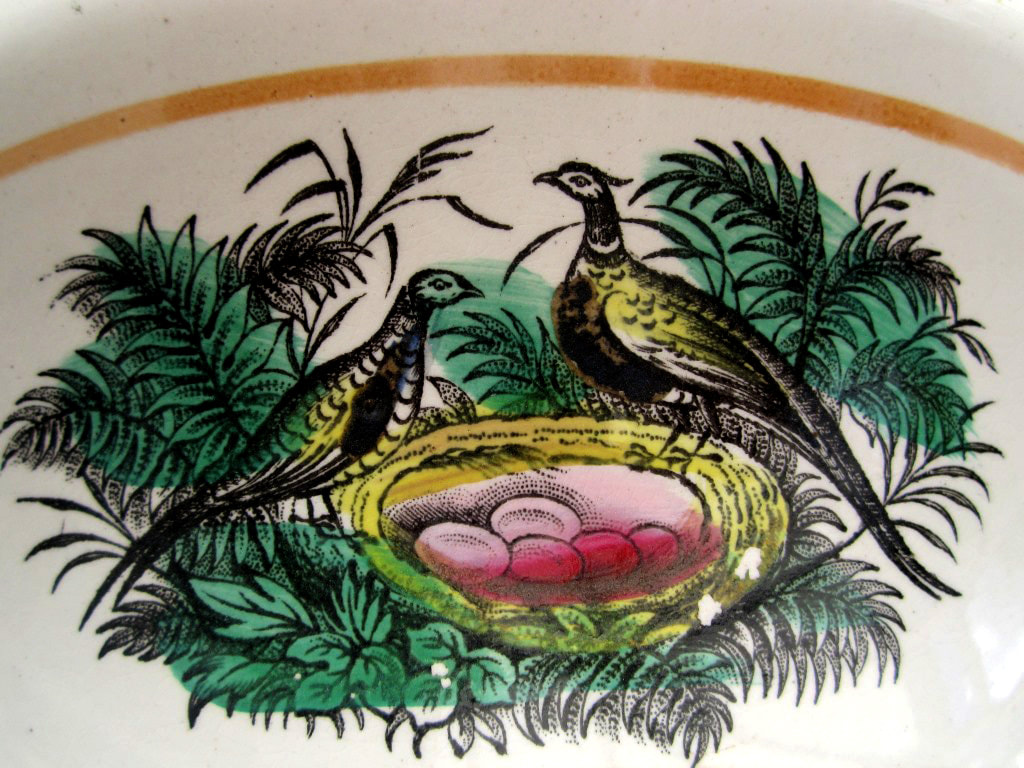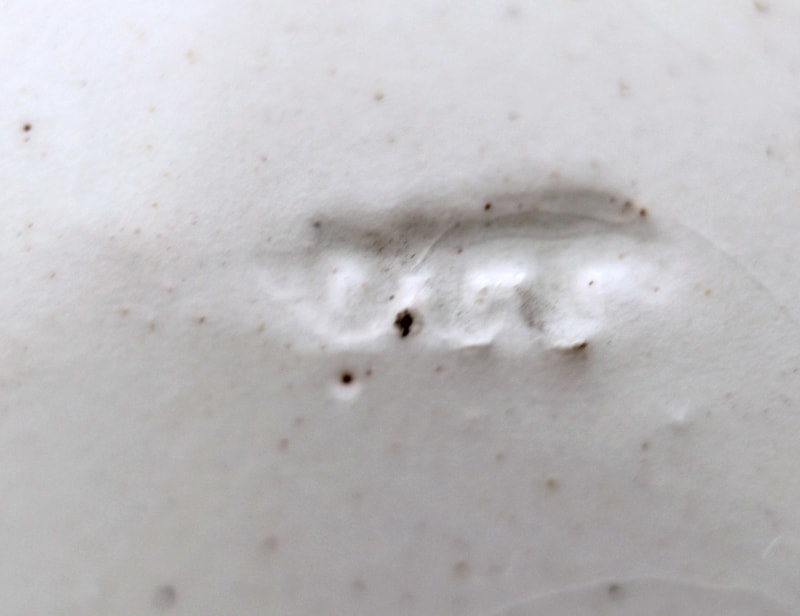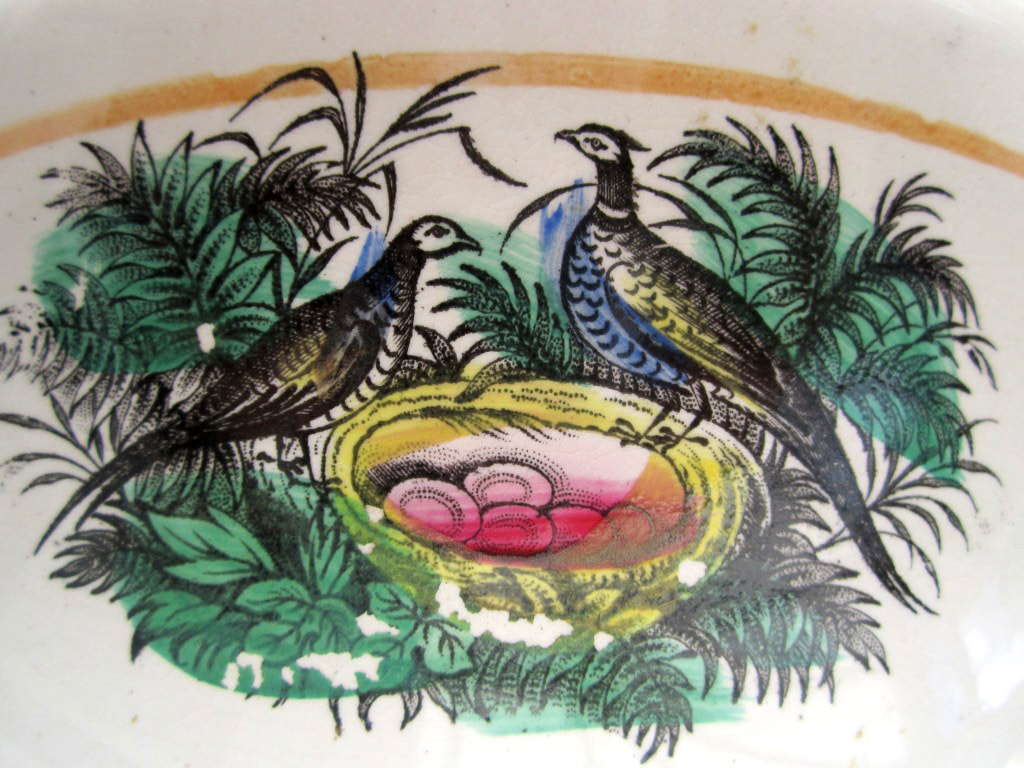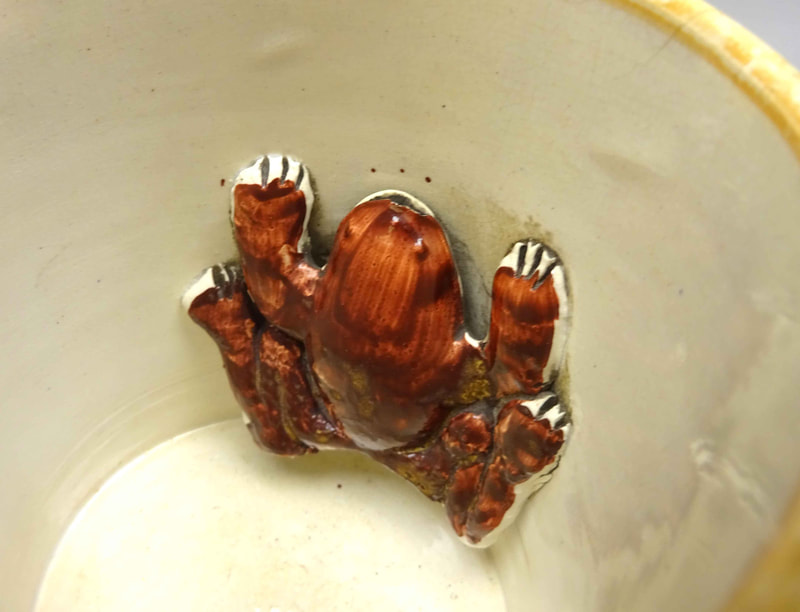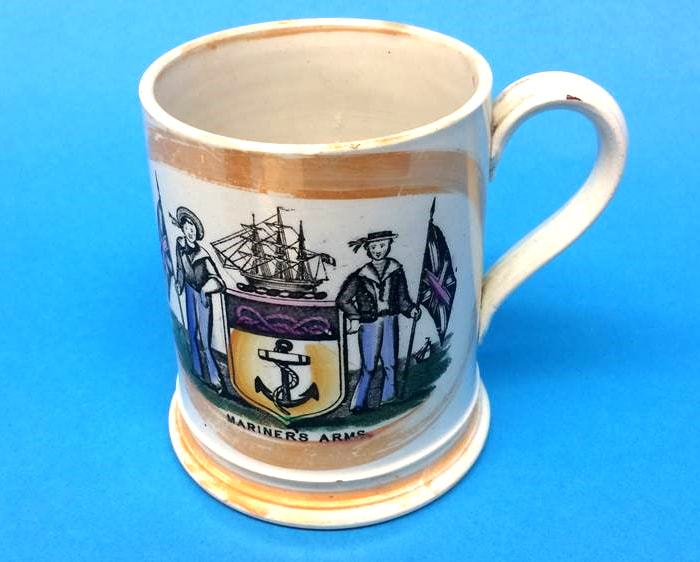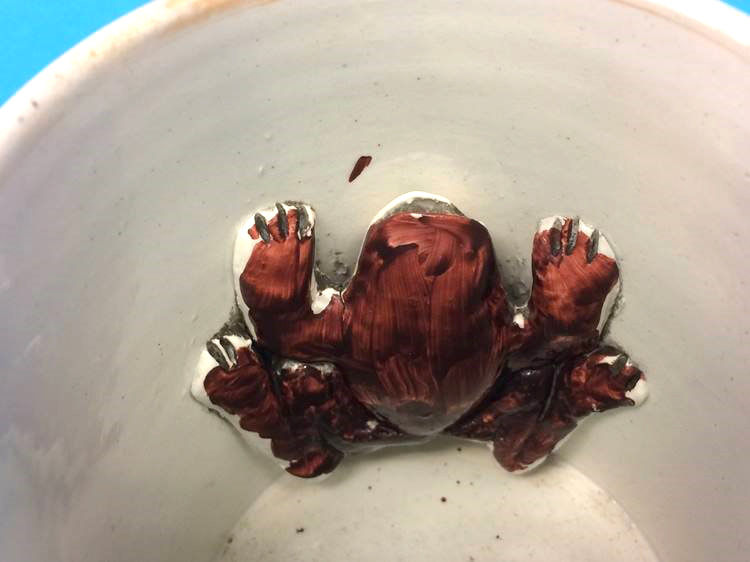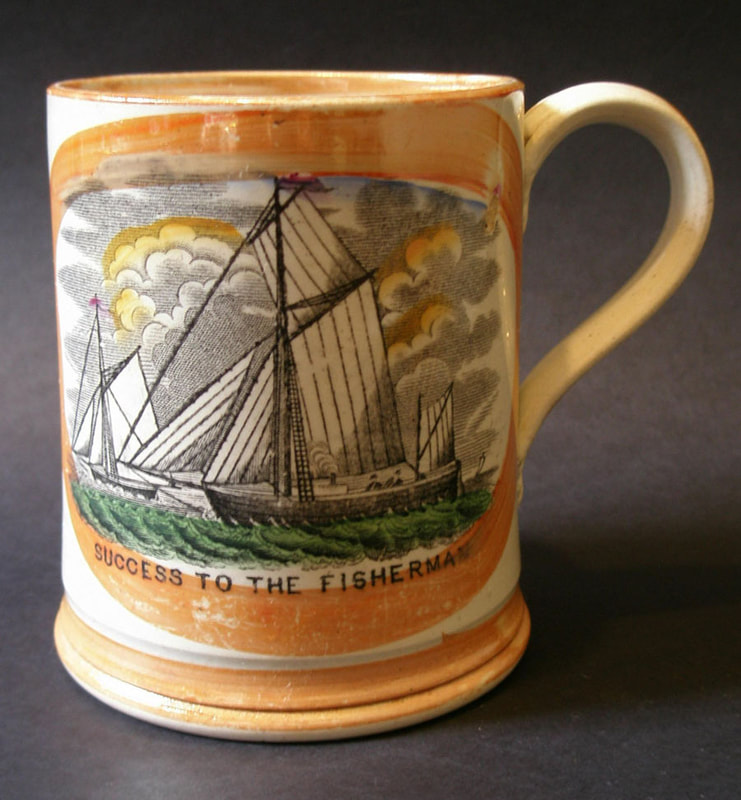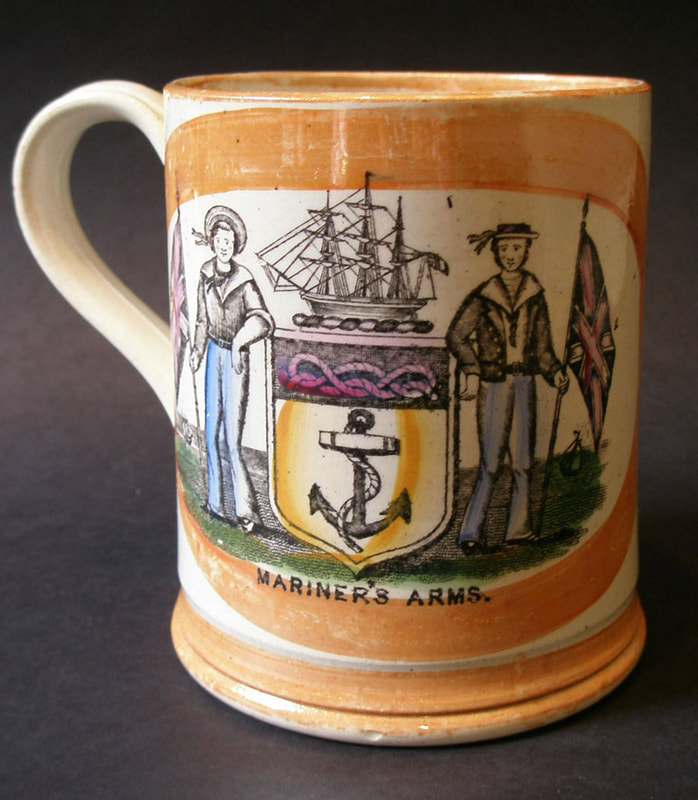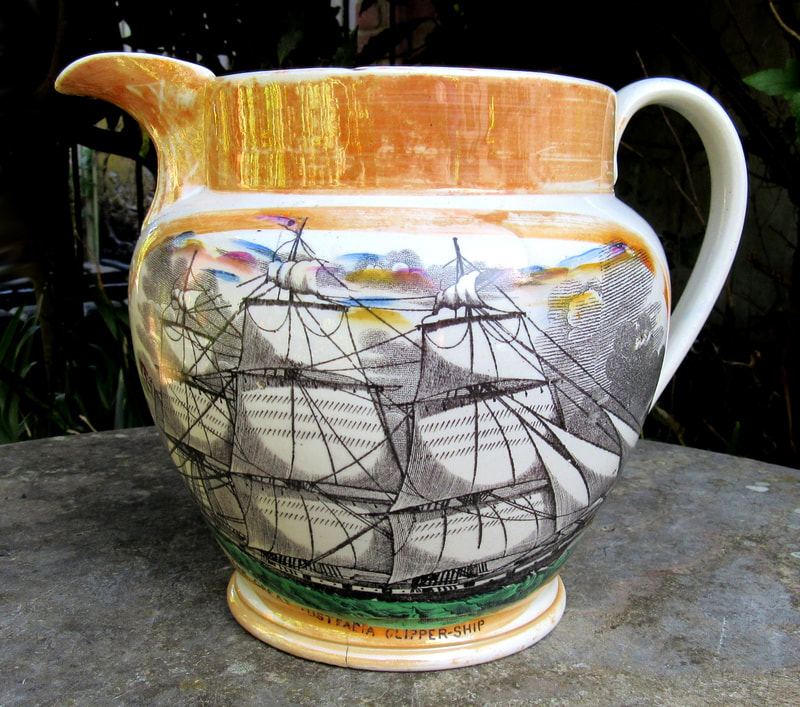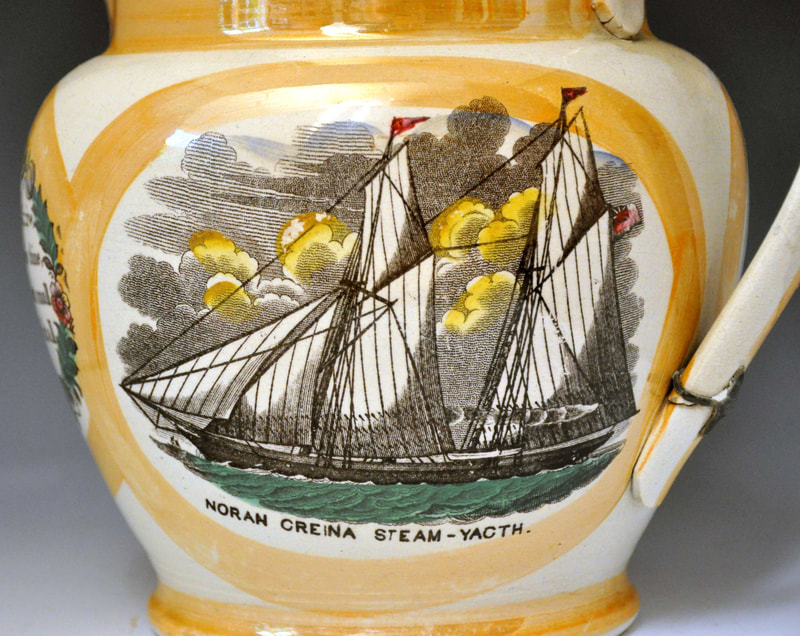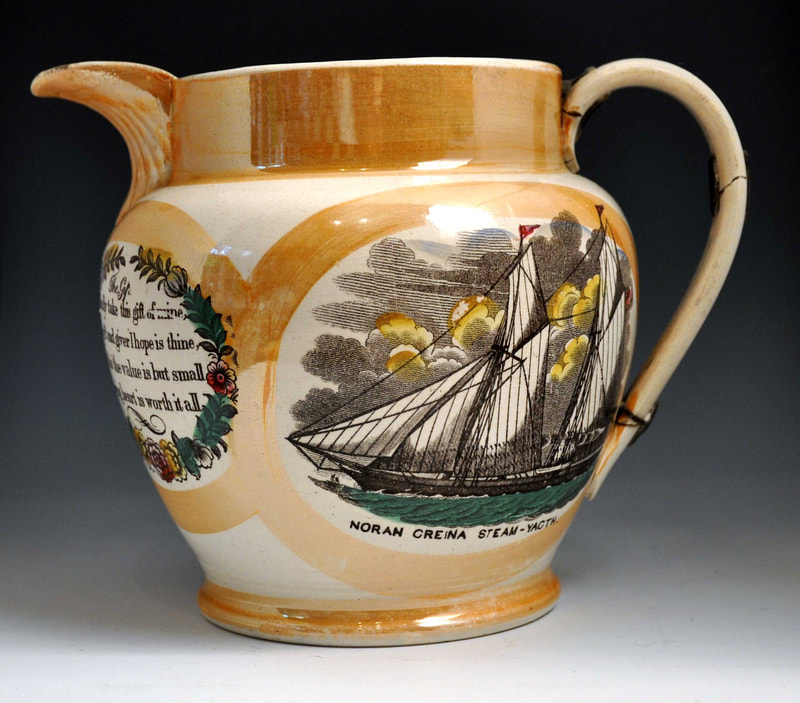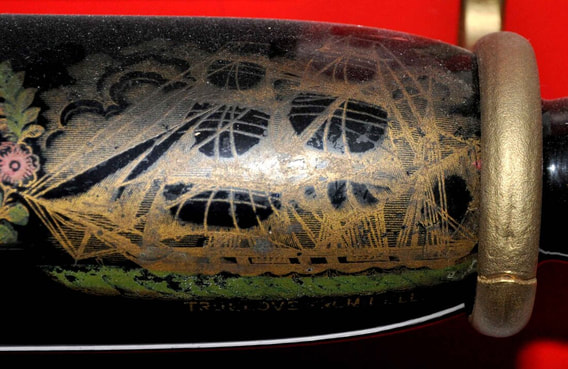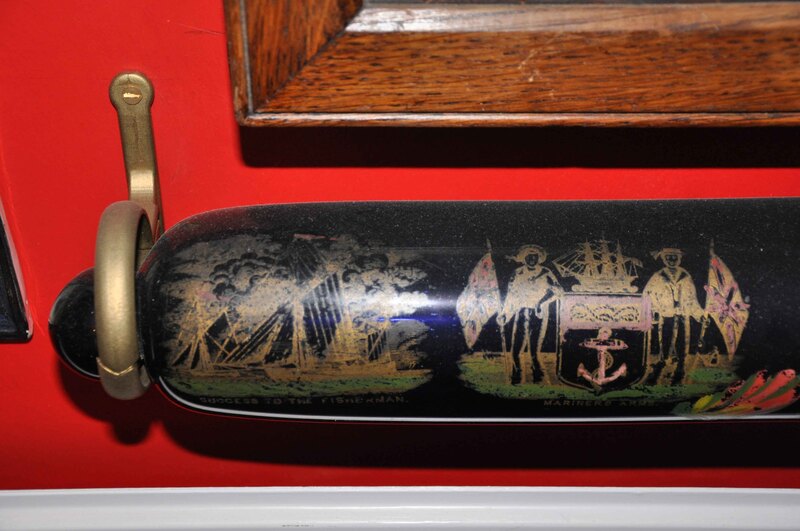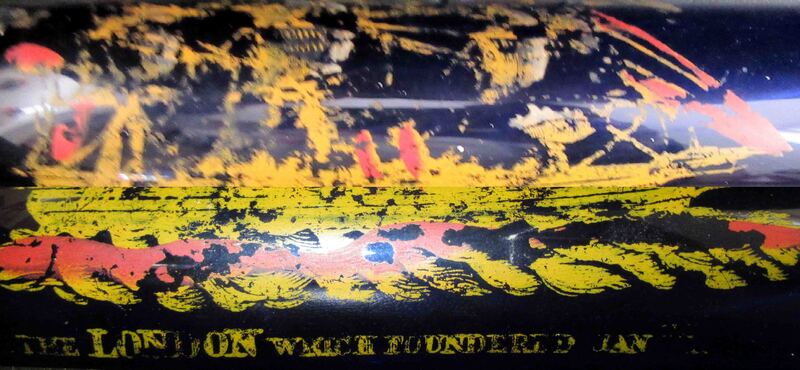Truelove from Hull / The Unfortunate London – Sunderland
|
I have put these ships together because they appeared side by side on the same copper transfer plate, now presumably lost. The dinner service to the right shows other transfers from that copper plate as follows. Pictorial transfers:
|
The copper plate appears to have been commissioned by Moore's Wear Pottery, in Southwick. The SS London sank in 1866, two years after its launch. So that means that the copper plate was engraved right at the end of the pink lustre period, and just as orange lustre was coming into fashion. This explains why pink lustre examples with these ship transfers are relatively scarce.
The interdependencies between the various Sunderland potteries become more complex after 1860. Moore's had stepped up production, increasing its workforce (Baker says that between 1866 and 1872 the pottery was the largest on Wearside), and Scott's neighbouring Southwick Pottery was sending plain earthenware ('blanks') there for decoration. This accounts for the large number of impressed Scott items with decoration more commonly associated with Moore's.
What happened after that is pretty much guesswork, as few records exist. Norman Lowe has hypothesised that by the 1870s, both potteries were sending wares to Sheepfolds Warehouse for decoration. That would account for the number of glass rolling pins that bear transfers from this copper plate. Sheepfolds were known to have decorated such items. Finally, like many copper plates, it seems to have found its way to Ball's Deptford Pottery, the last pottery on Wearside to continue making so called 'Sunderland ware'. According to Baker, Moore's closed in 1882 and Scott's in 1893. In the absence of inscriptions, it is very difficult to date the items on this page, and the orange lustre wares could have been made by either Moore's, Scott's or even Ball's.
The interdependencies between the various Sunderland potteries become more complex after 1860. Moore's had stepped up production, increasing its workforce (Baker says that between 1866 and 1872 the pottery was the largest on Wearside), and Scott's neighbouring Southwick Pottery was sending plain earthenware ('blanks') there for decoration. This accounts for the large number of impressed Scott items with decoration more commonly associated with Moore's.
What happened after that is pretty much guesswork, as few records exist. Norman Lowe has hypothesised that by the 1870s, both potteries were sending wares to Sheepfolds Warehouse for decoration. That would account for the number of glass rolling pins that bear transfers from this copper plate. Sheepfolds were known to have decorated such items. Finally, like many copper plates, it seems to have found its way to Ball's Deptford Pottery, the last pottery on Wearside to continue making so called 'Sunderland ware'. According to Baker, Moore's closed in 1882 and Scott's in 1893. In the absence of inscriptions, it is very difficult to date the items on this page, and the orange lustre wares could have been made by either Moore's, Scott's or even Ball's.
Moore & Co's Wear Pottery and Scott's Southwick Pottery
The jugs with these ship transfers are always unmarked. The heavily lustred collars and zig-zag lustre decoration are, however, associated with Moore's pottery. The last jug shows the fantastic restoration work of Hull Maritime Museum.
Another possible pairing for these transfers is the Norah Creina Steam-Yacht (see right below). The transfer is again of larger than average size. The image appeared in the Illustrated London News in 1859.
Below, a large jug with an additional handle to aid pouring, with all of the transfers from the copper plate. See the Great Australia Clipper Ship page for another similar example.
In theory, all of the transfers from the copper plate should exist on the plaque forms below. There are, however, extremely rare. Success to the Fisherman and The Gift, are yet to be recorded on a plaque. The first three brown-bordered plaques are of a form used by Moore's in the 1860s. The fourth and fifth plaques are of a mould used by Galloway and Atkinson at the Albion Pottery. That pottery closed c1864 and the mould appears to have been acquired by Moore's. The last two orange lustre plaques, c1870, are on a plaque form peculiar to Scott's.
An unmarked wash basin of a shape used by both Moore's and Scott's. The heavy pink-lustre decoration to the interior is typical of Moore's Wear Pottery.
Another with orange lustre and similar striped decoration to the exterior.
A similar unmarked bowl with wavy orange-lustre decoration and the Unfortunate London transfer.
A large jug with similar wavy lustre decoration to the bowl above.
Below, a striped washbowl with its ewer. I don't know whether the bowl has an impressed mark.
The bowl below is of similar shape and decoration to those above, but has a partial SCOTT impress. It also has the Truelove and Gift transfers, but more unusually, it is decorated with pheasants around the outside. I have one recorded example of a pink lustre wash basin with the Scott impress, but the photo is too poor to include here.
Three frog mugs with transfers from this copper transfer plate. The frog is of a form associated with Scott's Pottery. Baker writes, that 'Scott's supplied earthenware to Moore's Wear Pottery [...] presumably plain for decoration' (Baker page 54). Another possibility, by this late period, was that both potteries were sending items to neighbouring Sheepfolds Warehouse to be decorated. I have a large blue rolling pin with this transfer (see below), and Sheepfolds were known to have decorated such items.
Below, three orange jugs from the 1870s. The second, again pairing transfers from this plate with the Norah Creina Steam-Yacht.
These plates are unmarked. However, the green enamel decoration is found on mugs and bowls attributed to Moore's.
Attributed to Sheepfolds Warehouse
The transfer printed in gold on a blue glass rolling pin. Norman Lowe, who has a similar pin with a transfer of the 'Star of Tasmania', has suggested that by the 1870s, the copper plates with these ship transfers had been moved to Sheepfolds Warehouse which, employing the principles of division of labour, decorated white earthenware items for both Moore's and Scott's. Sheepfolds was known to have had a sideline in decorating rolling pins.
Attributed to Ball's Deptford Pottery
The rolling pins below are of a kind associated with Ball's Pottery. Balls was the last of the North Eastern potteries to continue producing 'Sunderland ware' and became a repository for copper plates and moulds from both Sunderland and Tyneside potteries. These pins come with a mixture of transfers from different potteries. Balls continued to produce 'Sunderland ware' items of varying quality into the early 20th century.
Unknown maker – perhaps Tyneside
These particular transfers have not yet been recorded on items of pottery. It is possible that the copper plates were used exclusively on glass.
The inscription is very worn in places but has words under the ship (see above), and a verse, which Ian Holmes has identified as Hymn 168 by C M Bouquet, Psalms and Hymns, 8th edition, 1829. There is text in the centre also, between the two transfers, which is now illegible.
|
THE LONDON WHICH FOUDERED JAN [ ]
IN THE BAY OF BISCAY WITH 2[ ] ON BOARD |
THOU, LORD! WHOM WINDS AND WAVES OBEY,
THE PILOT'S PART PERFORM; THE VESSEL STEER FROM DAY TO DAY, AND GUIDE HER THROUGH THE STORM |
The image of the ship is again degraded, but probably looked something like the image below, taken from this Wikipedia page.
